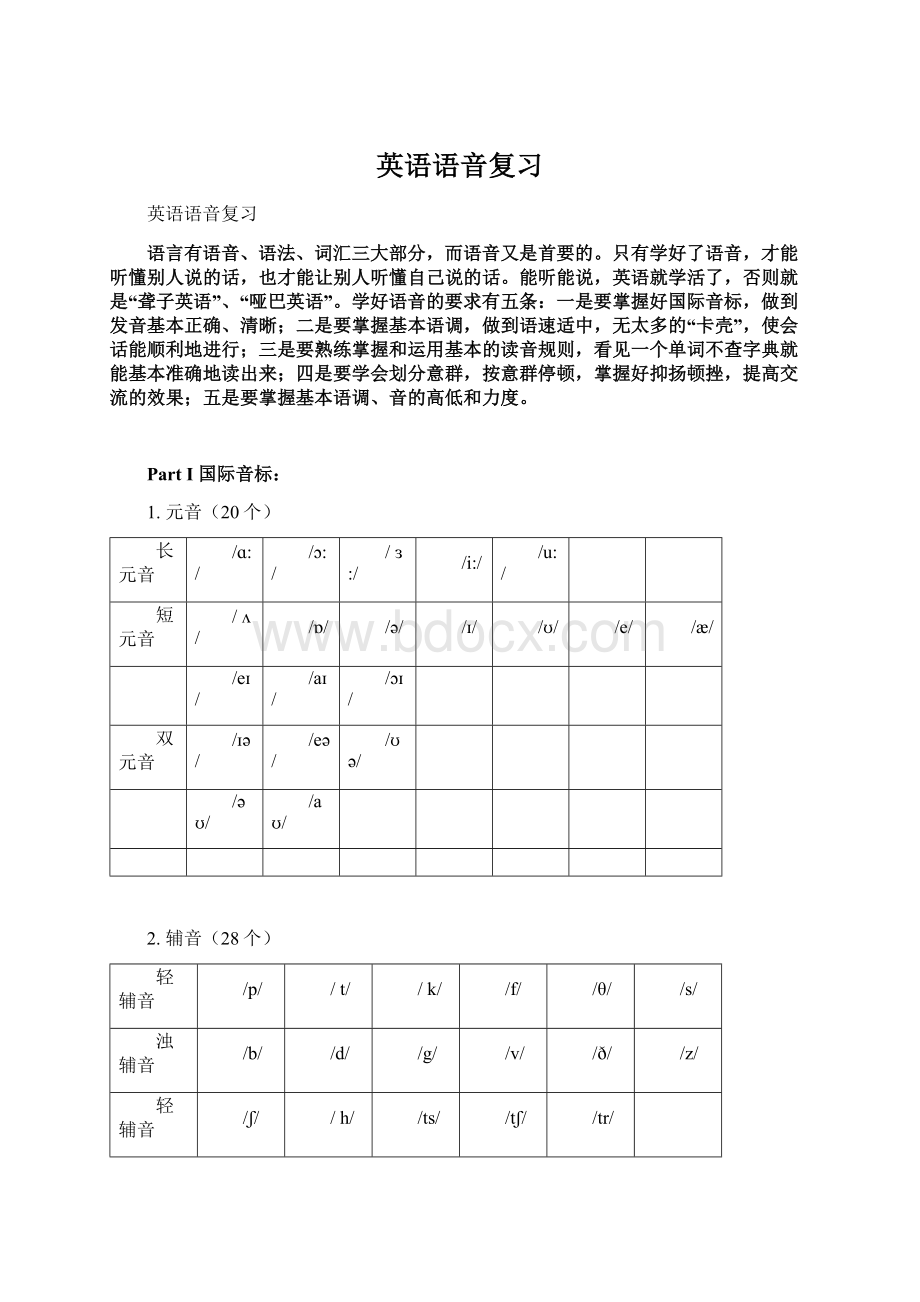英语语音复习.docx
《英语语音复习.docx》由会员分享,可在线阅读,更多相关《英语语音复习.docx(44页珍藏版)》请在冰豆网上搜索。

英语语音复习
英语语音复习
语言有语音、语法、词汇三大部分,而语音又是首要的。
只有学好了语音,才能听懂别人说的话,也才能让别人听懂自己说的话。
能听能说,英语就学活了,否则就是“聋子英语”、“哑巴英语”。
学好语音的要求有五条:
一是要掌握好国际音标,做到发音基本正确、清晰;二是要掌握基本语调,做到语速适中,无太多的“卡壳”,使会话能顺利地进行;三是要熟练掌握和运用基本的读音规则,看见一个单词不查字典就能基本准确地读出来;四是要学会划分意群,按意群停顿,掌握好抑扬顿挫,提高交流的效果;五是要掌握基本语调、音的高低和力度。
PartⅠ国际音标:
1.元音(20个)
长元音
/ɑ:
/
/ɔ:
/
/ ɜ:
/
/i:
/
/u:
/
短元音
/ ʌ/
/ɒ/
/ə/
/ɪ/
/ʊ/
/e/
/æ/
/eɪ/
/aɪ/
/ɔɪ/
双元音
/ɪə/
/eə/
/ʊə/
/əʊ/
/aʊ/
2.辅音(28个)
轻辅音
/p/
/ t/
/ k/
/f/
/θ/
/s/
浊辅音
/b/
/d/
/g/
/v/
/ð/
/z/
轻辅音
/ʃ/
/ h/
/ts/
/tʃ/
/tr/
浊辅音
/ʒ/
/ r/
/dz/
/dʒ/
/dr/
鼻音
/m/
/n/
/ŋ/
半元音
/ j/
/w/
边音
/ ǀ/
PartⅡ音节
说话时最小的语音单位叫音节,通常由一个元音加上一个或几个辅音构成,但是单独一个元音也能成为一个音节。
辅音/l/,/m/,/n/在后面没有元音时,也能和前面的辅音构成一个音节。
音节按形式可分为开音节、闭音节和r音节三种;按音量可分为重读音节和非重读音节。
1.音节的种类
开音节:
以下两种音节属开音节。
1)以读音的元音字母结尾的音节,如:
go,me,flu。
2)以“辅音字母(r除外)+不发音的e”为结尾的音节,如:
blade,delete,slide,slope,mute。
闭音节:
以一个或几个辅音字母(r除外)结尾而中间只有一个元音字母的音节,如:
add,web,disc,dust,grasp。
r音节:
“元音字母+r”的音节称为r音节,如:
starve,herd,girl,short,burn等。
2.音节的划分:
音节划分的基本规则:
1)在两个音节的分界线上如果只有一个辅音字母(r除外),这个字母归右面的音节,第一个字母按开音节读音。
如:
stu·dent,a·dopt,be·have
2)分界线上有两个辅音字母(第一个不是r),这两个辅音字母分别划归左右两个音节,第一个音节按重读闭音节读音。
如:
chan·nel,com·mand,hos·tile
3)分界线上有两个辅音字母,第一个是r,这两个字母可分别划归左右两个音节,第一个音节按重读r音节读音。
如:
cor·ner,re·por·ter,shar·pen
但是如果分界线上的两个辅音字母是r,左边的重读音节按闭音节读音。
如:
nar·row,sor·row,spar·row,car·rot等。
PartⅢ单词重音
重读音节:
单词中读音特别响亮的音节。
重读符号为“'”,标注在重读音节前左上方,如:
/t
'm
r
u/,也可以直接在单词里标注,如:
to'morrow。
次重读符号“'”,标注在重读音节前左下方,如:
mu
nici'pality。
单音节词单独读时都重读。
如:
net,mouse,quit。
双音节词的重音多数落在第一音节上。
如:
'ten·nis,'con·text,'cop·per,但有前缀a-,be-,mis-,en-,ex-,im-,in-,re-等双音节词,重音一般落在第二个音节上。
如:
a·'bout,be·'fore,ex·'plain,re·'port,mis·'take。
以un-前缀开头和有后缀-teen的双音节词通常有两个重音。
如:
'un·'fair,'un·'known,'four·'teen,'thir·'teen。
双音节词加上前缀或后缀构成的多音节词,重音一般在原词根的重读音节上。
如:
un·'friend·ly,re'quire·ment,'of·fic·er。
多音节词的重音多数落在倒数第三个音节上。
如:
'im·mi·grant,im·'per·a·tive
次重音:
在含有3个或更多音节的单词中,有的除了有主重音还有次重音,次重音表示读该音节时要弱于重音节而强于其他音节。
如:
in·ter·'na·tion·al,re·
spon·si·'bil·i·ty
PartⅣ元音字母的读音
1.元音字母在重读开音节中的读音
元音字母
读音
例词
a
/ei/
pave,game,shape
e
/i:
/
free,see,bee
i
/ai/
life,mile,file
o
/əu/
code,logo,hope
u
/ju:
//u:
/
use,mute,menu
2.元音字母在重读闭音节中的读音
元音字母
读音
例词
a
/æ/
tag,black,packet
e
/e/
press,desk,set
i
/i/
this,six,milk
o
/ɔ/
box,log,clock
u
/
/
nut,hub,lunch
3.元音字母在重读-r音节中的读音
元音字母组合
读音
例词
ar
/α:
/
bar,start,market
or
/
:
/
sport,short,port
er
ir
ur
or(w之后)
/
:
/
her,certainly,herb
bird,first,shirt
turn,nurse,purpose
word,worse,worm
4.元音字母在非重读音节中的读音
字母
读音
例词
a
/
/
China,another,breakfast
/
/
orange,village,cabbage
e
/
/
hundred,student,moment
/
/
chicken,pocket,children
i
/
//
/
holiday,beautiful,animal
/a
/
exercise,satellite,memorize
o
/
/
second,tonight,welcome
/əʊ/
also,zero,photo
u
/
/
autumn,difficult,maximum
/ju(:
)/
popular,congratulation,January
注:
u处在开音节位置,又在辅音字母j﹑l﹑r﹑s后面时,读/u(:
)/音,例如:
July,influence,February,issue。
5.常见元音字母组合在重读音节中的读音
元音字母组合
读音
例词
aiay
eiey
/ei/
say,again,play
eight,they,grey
al
/o:
/
ball,talk,wall
ea
/i:
/
tea,teacher,please
ee
/i:
/
green,bee,three
oa
/əʊ/
boat,coat,load
oo
/u:
/
noon,moon,food
/ʊ/
look,book,cook
ou
ow
/aʊ/
mouth,house,about
how,brown,down
oioy
/ɔɪ/
boy,toy,noise
PartⅤ辅音字母的读音
辅音字母的读音都比较固定,除c,g,s,y外,字母和音标几乎一一对应。
c—在e,i,y前读/s/,在其他情况下读/k/。
例如:
certify,circuit,cycle;cabinet,comedy
g—在e,i,y前读/
/,在其他情况下读/g/。
例如:
shortage,giant,gymnasium;gallon,global,graceful
s—在一般情况下读/s/,在两个元音字母之间读/z/。
例如:
salary,structure;visible,suppose
y—在音节开头、元音字母前读/j/,在其他情况下读/ai/或/i/。
例如:
yell,yield;satisfy,classify;copy,city。
1.辅音字母的读音
辅音字母
读音
例词
b
/b/
board,bike,blue
c
/k/
cake,card,cape
/s/
face,bicycle,cinema
d
/d/
desk,disc,depth
f
/f/
fine,fight,off
g
/
/
orange,large,college
/g/
goods,bag,glass
h
/h/
hello,hat,hand
j
/
/
jacket,job,June
k
/k/
keyboard,like,bike
l
/l/
yellow,life,lake
apple,full,bottle
m
/m/
morning,name,memory
n
/n/
novel,nice,needle
p
/p/
grasp,happen,pleasure
r
/r/
rose,rocket,respect
s
/s/
spell,thanks,silver
/z/
please,nose,expose
t
/t/
what,white,tennis
v
/v/
evening,invest,visible
w
/w/
woory,waitress,well
x
/ks/
box,exercise,experience
y
/j/
you,yellow,youth
z
/z/
zoo,zero,realize
2.常见辅音字母组合的读音
sh
/
/
English,shine,ship
ch/tch
/
/
China,chess,match
th
/θ/
thank,three,thrive
/
/
that,they,thereafter
ck
/k/
black,chick,check
ph
/f/
phone,property,purpose
wh
/w/
what,white,whisper
/h/
who,whose,whole
tr
/tr/
tree,trick,trip
dr
/dr/
dress,dragon,driver
ts
/ts/
cats,students,peasants
ds
/dz/
beds,hands,cards
qu
/kw/
quite,quiet,question
Exercises
1.利用开闭音节读音规则拼读下列单词。
blame
bathe
grace
spade
grade
shape
skate
save
wave
shave
black
snack
passive
match
matter
chat
catch
watch
smash
rat
meter
eve
bee
peter
see
evil
even
evening
fever
vehicleet
neck
pet
bet
wet
desktop
forget
neck
inspect
section
inspect
dive
file
hide
hike
shine
thrive
smile
provide
slide
knife
disc
fish
habbit
rabbit
missing
transmit
permit
picture
knit
tissue
slope
globe
code
hope
hole
notice
notebook
smoke
expose
propose
rock
cock
gossip
robber
rocket
shock
socket
pocket
stock
topic
mute
tube
use
mule
usage
nucleus
universe
pupil
duty
cubic
shut
luck
duck
number
rubber
public
puppy
shuttle
numb
conduct
sharp
bark
mark
park
market
target
starve
carve
barter
carpet
sport
dorm
norm
port
porket
shortage
storage
export
transport
passport
expert
exert
invert
observe
dirty
skirt
shirt
nurse
curve
burst
2.拼读下列单词(所选例词均为四级词汇,同时注意读音与拼写的关系)。
ashabsorbacquisitionanthropologistbeneficial
biologycandidatecommunitycopyrightcurrency
deadlinedeliberatedisorderembarrassexaggerate
exitfeedbackfinancialfortnightgeometry
highlighthonorablehydrogeninhabitantinitiative
junglekneellanemoisturemyth
nightmareopticalphysicianpsychologicalqualification
resembleriddleshrinkspitsuicide
tametagthrivethumbtractor
utilityvirtuewaterproofwidespreadworship
creationcustomerbreezechampionceremony
chartercivilizationcontainerconstitutiondestination
layoutlifetimemusiciannationalityscholarship
exitgraphdecodedefinecatalog
deletemarkerreserverefileframe
PartⅥ一些常见的语音现象
1.句子重音:
实词重读,虚词轻读。
句子重音体现句子的节奏感和韵律感,突出重点,使听者更容易理解。
在句子中,实词(名词、代词、数词、动词、形容词、副词)通常需要重读,而虚词(冠词,单音节介词,单音节连词,人称代词,反身代词,物主代词,关系代词,相互代词,助动词,情态动词和系动词be)往往不需要重读。
实词在下列特殊情况下不需要重读。
1)实词第二次出现。
例如:
Hethinksofthatasachildthinks.
2)一个名词被另一个名词修饰。
例如:
Imetherintherailwaystation.
3)代替词。
例如
Whichbookdoyouwant?
Thesmallone.
4)感叹词中的what和how。
例如:
Whatagooddayitis!
Howbeautifulsheis!
5)street在专有名词中。
例如
WangfujingStreet.
虚词在下列特殊情况下需要重读。
1)情态动词,助动词和系动词be在句首,句尾和否定时。
例如:
Doyoulikeit?
Yes,Ido.
Canyouhelpme?
Yes,Ican.
Idon'tlikethis.
Heisn'taworker.
2)情态动词表示可能,惊奇和肯定时。
例如:
Theymaycomethisevening.
Canitbefivealready?
Hemustbeintheroom.
3)介词在句首和句尾。
例如:
Inthebox,hefoundaletter.
HeisthepersonItalkedwith.
4)引导复合句的连词在句首。
例如:
Ifyouwish,I'llvisityou.
Whenhecomes,I'lltellhim.
5)反身代词表示强调。
例如:
Hecouldn'tcomehimself.
Exercises
朗读下列句子。
1.Thereisabookonthedesk.
2.Mysisterputupapictureonthewall.
3.Johnwantstoseetheteacherafterclass.
4.Shereadsalotaboutthecountry.
5.Anelephantisananimal.
6.Understandingtheculturehelpslanguagelearning.
7.Thelanguageishardtolearn,butit’sinteresting.
8.Don’ttellmeaboutthat!
Itsoundssogreat!
9.Whataboutyou,Ken?
Whereareyouplanningtotakeyourvacation?
10.Justthink,inafewdaysI’llbeswimmingeveryday,playingbeachball,lyinginthesunandjusttakingiteasy.
2.连读
在连贯地说话或朗读时,在同一个意群(即短语或从句)中,如果相邻的两个词前者以辅音音素结尾,后者以元音音素开头,就要自然地将辅音和元音相拼,构成一个音节,这就是连读。
连读时的音节一般不重读,只需顺其自然地一带而过,不可以加音,也不可以读得太重。
例如:
在读notatall这个短语时,听起来就像是一个单词。
注意:
连读只发生在句子中的同一个意群中,在两个意群之间即使有两个相邻的辅音和元音出现,也不可连读。
例如:
Pleasetakealookatit.这个句子中takealookatit是同一个意群,那么take与a可连读,look与at可连读,at与it可连读。
在Thereisabookinit.一句中book与in往往不连读,因为book与in分别在两个不同的意群中。
Exercises
朗读下列句子,注意连读。
1.Takealookatit.
2.I’llbebackinhalfanhour.
3.Thereisapairofshoes.
4.Shewasawayfromherowncountryforalongtime.
5.Shallwemeetatteno’clocktomorrowmorning?
6.Eachofushadasandwichandacupoftea.
7.Isitverycloudyoutside?
8.Therearemanybooksandnotebooksonthedesk.
9.Inourmodernage,weusealotofelectricity.
10.Manyofuswillgoouttonight.
3.停顿
在说英语时,如果想要清晰、流利地表达你的意思,运用好停顿是非常关键的。
同时,在朗读英语时养成良好的停顿习惯,可以慢慢培养一种英语逻辑思维,从而更容易接受英语,掌握英语,并运用好英语。
在一个句子里语法关系非常密切,不能再分割的单位,叫一个意群。
意群可以是一个单词,也可以是一个词组,但是一个意群里至少有一个重读音节。
每个意群中不能停顿,但意群之间可以作短暂的停顿。
一个较长的句子,一口气讲完有困难,或无法使对方明白自己的意思,通常会在每个句子成分后有一个停顿,如主语部分,谓语部分,宾语部分,状语部分,从句子等。
Exercises
划分意群并正确朗读下列句子。
1.Theskyisblueandthesunisbright.
2.I’mjustwonderingwhereyougotthatstupididea.
3.He’stheonewhobreaksmyheartandplungesmeintodepression.
4.ThepassagetellsusthatlastweektherewasbadweatherallthewayfromtheEastCoasttotheWestCoast.
5.LastSundayevening,mostofmyclassmateswenttoChristmaspartyheldbyMr.John.
6.DuringtheSpringFestival,asarule,theChinesepeoplehaveaget-togetherorvisitfriends.
7.Thewomanissurethathersonwon’tdoallthethingsthemanmentionedwhenhegrowsup.
8.Duringsummerwhent